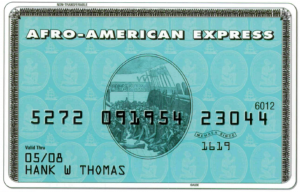
Hank Willis Thomas said, in relation to “Absolut Power” (an inkjet print on canvas and paper, 2003) that “Racism is the most successful advertising campaign of all time. Africans have hundreds if not thousands of years of culture. Having all of these people packed into ships and then told they’re all the same, reducing them to a single identity—that’s absolute power.” The juxtaposition of the centuries-old feel of the slave ship engraving with the bracing modernity of the ad forces a connection between past and present, as well as relating racist propaganda to the modern advertising industry the way the artist describes.
The jolt derives from the fact that the piece looks precisely like a modern advertisement, with just a few crucial details changed. The efficacy of the Absolut ad campaigns lies with the resonance of an ad consumers can recognize; for each new variety of vodka, that company releases advertisements with identical baseline features, and just a few tweaks to show how the new product is different from the last. Willis relies on this same strategy, only rather than comparing vanilla flavored vodka to citrus, he’s comparing modern consumerism with the 19th century consumerism that prompted the gruesome suffering of millions. The primary shape is that of a bottle, with the text in its recognizable font recalling the familiar ad; but upon closer examination, the bottle is a 19th century engraving of the cross section of a ship, the hold packed with bodies placed head to foot with two spaces for ‘store rooms.’
“Afro-American Express” relies on a similar dynamic as “Absolut Power”; it takes an easily recognized symbol of modern consumerism, here an American Express card, and tweaks the details to recall slavery. The edge of the card, as opposed to the typical engraving flourish, is an engraving of packed black bodies similar to the image in “Absolut Power,” clearly taken from or mimicking an old drawing of a slave ship. The background of the card, rather than a repetition of an engraving of the company name, is the iconic image used by the Society for the Abolition of the Slave Trade, an engraving of a shackled slave on bended knee with his clasped hands outstretched above the (seemingly rhetorical) caption, “Am I Not a Friend and a Brother?” The image was used by the abolition movement to provoke examination of that very question—it’s used here by Thomas to state that for far too long, the man depicted in the image was nothing of the kind. Each detail is crucial⎯ where the typical card would say “Member Since [the cardholder has been a customer of American Express],” the card here says “Member Since 1619”; the first recorded date captive Africans were sold into slavery in the North American colonies. And the central image is not the profile of the trademark American Express Grecian man, but the deck of a slave ship.
This juxtaposition of modern consumerism and the slave trade is a key element for Thomas, and for other contemporary African-American artists working with similar themes⎯ Carrie Mae Weems, Kara Walker, Kerry James Marshall for example. For them, the Middle Passage isn’t in an artistic abstract; it’s a concrete historical event that culminated in immense ramifications for what it means to be a person of color in America. “Absolut Power” is chilling not only for the way in which it recalls a banal, commonplace ad, but because of the explicit connection of liquor to the Middle Passage, so named because it was the second leg of the ‘triangle trade’—sugar, tobacco, and cotton to Europe, textiles, manufactured goods and rum to Africa, and slaves to the Americas. Alcohol was one of the commodities traded for human life.
Both pieces⎯ “Absolut Power” and “Afro-American Express”⎯ combine symbols of modern materialism to remind us that it is the suffering of slaves from which that consumerism got its initial push. The ethics of consumerism of the modern and the 19th century customer can seem like night and day, which is why Thomas’s work is so important.

Sir I want to know about the retroreflective ink .. And also want to know the from hank Williams Thomas about his work in freedom rider why he puts colors on some image and some our without color….